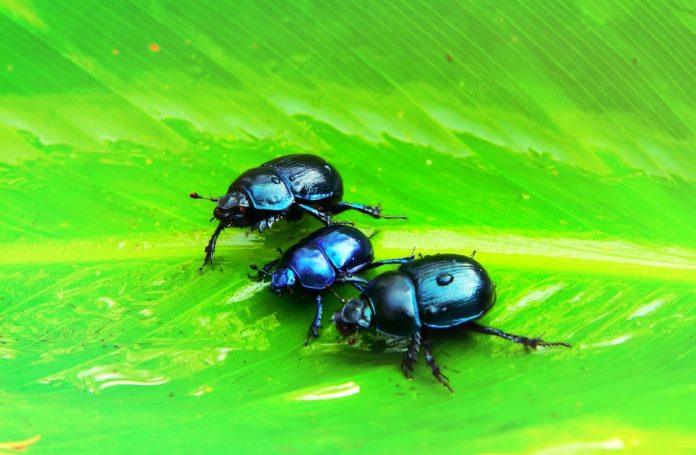
This is no science fiction, but there are animals with crazy blood colors that aren’t just yellow. Yes, some animals, even the common ones we may not have known of, possess differently colored blood that isn’t just red like humans and most other vertebrates. From green to blue to purple and even colorless, this post is a colorful ride of interesting facts from start to finish.
Read on to know which animals have different blood colors and why they possess these surprising colorations at all!
Which Animals Have White Blood/Clear Blood?
When scientists first heard of it, they thought it was a haox, but some creatures do have white blood. The most prominent example would be the crocodile icefish or the ocellated icefish living in the cold waters surrounding Antarctica that has blood, which is gin-clear.
When the blood from the icefish clots, it looks like cream, more like whipped cream!
The question, however, is, why is their blood white? If we’re talking about icefish, their blood lacks respiratory pigments- these pigments are majorly the reasons why animals have colored blood. But how do they get by without having any respiratory protein?
The answer lies in their habitat and distribution in the cold waters of Antarctica- the respiratory pigments are usually required to transport oxygen throughout the body. However, the antarctic or the Southern Atlantic waters contain more oxygen; thus icefish do not have to rely on a pigment to transport the oxygen which is already available in abundance in their habitat.
The other reason is that icefish, living in cold waters, are slow-moving and do not require much oxygen in comparison to the active fishes in the warm waters, thereby getting away without respiratory proteins, the absence of which renders the blood colorless!
On the other hand, insects lack hemoglobin or any respiratory pigment that can impart a vibrant color to their blood. Their blood contains hemolymph that has pale pigments giving it a murky and pale white color. However, the blood isn’t clear or absolutely colorless like the icefish, so do not mistake them to fall under the same category when it comes to colored blood.
1.) The Ocellated Icefish
Ocellated Icefish have grayish, black, or brownish bodies with two dorsal fins supported by long and flexible spines, wide pectoral fins, and no scales; it helps them to absorb more oxygen directly through the skin, therefore not requiring hemoglobin. Their diet consists of a variety of marine animals and plants, including plankton, krill, and small fish.
Icefish are able to maintain their liquid blood in a below-freezing temperature, and they can easily swim in freezing waters. Ocellated Icefish live deep down in the cold waters at 200-400 m, found in the Southern Ocean, South Orkney Islands, Antarctica, and the South Shetland Islands with physical characteristics asserting a growth of up to 52 cm in length and a lifespan of 3-8 years.
Ocellated Icefish have a gin-clear blood color (which is transparent hemoglobin free blood). They do not use hemoglobin to transport oxygen through their bodies; rather, the amount of oxygen they use gets dissolved in the plasma of blood, which is why the pigment (that gives the red color to the blood) is absent overall, making their blood white.
2.) Insects
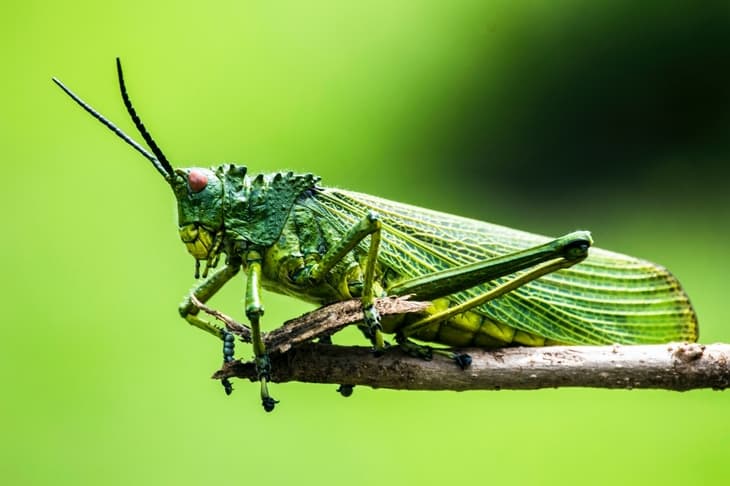
All insects and most other invertebrates do not have RBCs, unlike humans, that give the reddish color to the blood. Instead, they have a heterogeneous fluid called hemolymph that contains some pigments apart from ions, carbohydrates, and hormones, amongst other things. The pigments are somewhat pale and bland, which is why the insect blood is usually white, tending towards a tinge of yellow or even green.
If you’ve ever quashed a housefly, you must have seen the color red, but it has pale white blood, and the red color is imparted from the pigment in the eyes.
Which Animals Have Purple Blood?
Many marine invertebrates such as brachiopods, penis worms, peanut worms, and others rely on the protein hemerythrin to transport oxygen throughout the body. The absence of hemoglobin should have rendered the blood colorless; however, hemerythrin, when bound with oxygen, turns the blood to a deep purple or violet-to-pink color.
1.) Peanut Worms
The peanut worm’s body is flexible and mobile, divided into unsegmented and bulbous trunks, with a narrow anterior section called the introvert. The introvert houses the mouth at its tip that is surrounded by a ring of tentacles. These wrangling creatures are bottom-dwelling creatures who can survive both in warm and cold water habitats, living in burrows in mud or sand, in rock crevices, and in empty seashells.
Their diet mainly consists of detritus and the edible bits that come in their way while they burrow in the sand. Peanut Worms are marine and benthic found throughout the oceans of the world, with their abundance in coralline rock and in burrows in the rocks in Hawaii.
Peanut Worms have dark purple color blood, which appears almost black, due to the presence of hemerythrin protein in the blood. When the blood is oxygenated, it contains protein, which turns blood from colorless to purple, thus looking somewhat mauve or lilac when seen through naked eyes.
2.) Brachiopods

Also known as lampshells, brachiopods are small marine shellfish known to exist on Earth for more than 550 million years. These benthic (bottom-dwelling) marine creatures are rare to spot in today’s era, but they were abundantly populated during the Paleozoic Era, dominating the sea floors and literally ruling the water world!
Brachiopods inhabit sea beds, shallow water such as the rock pools, intertidal zones, crevices, and undersides of boulders. Although rare, they can be found in the seabeds of tropical to cold waters in the Arctic and the Antarctic Ocean.
Opening their shells to take in whatever food the current brings in, brachiopods have a horseshoe-shaped organ called lophophore that filters the food taken in from the seawater. Their lifespan ranges from 3 to more than 30 years, and their diet consists of plankton and particles of dead organic matter- basically anything the currents draw in.
Although the deoxygenated blood is colorless, brachiopods have deep purple colored blood in its oxygenated state. However, that also tends to be pinkish at times if the respiratory pigment hemerythrin is in lesser amounts than usual.
Which Animals Have Blue Blood?
This may not be an alien movie, but animals with blue-blood exist! In fact, the one animal that hid in plain sight for so long with vibrant blue blood is spider!
When the human version of color-imparting protein is hemoglobin, it’s hemocyanin for some animals like horseshoe crabs, spiders, and even those lethal scorpions. The respiratory pigment hemocyanin isn’t blue since the beginning; however, when it binds with oxygen, the copper in the pigment (upon binding with oxygen) imparts the blue color to the blood.
1.) Spiders

Spiders are air-breathing arthropods with unique anatomy, which includes their eight jointed legs, absence of antennae, bodies divided into two segments, exoskeleton, with six to eight eyes. Spiders generally prey on all kinds of organisms, including arthropods, small birds, frogs, reptiles, and have a wide variety of strategies to capture prey.
The majority of the spider species are terrestrial, while some specialized species are able to live in freshwater. The spiders construct their webs usually at a potential nesting location with ample space to lay their eggs and store enough food.
If it’s only the scary looks and the pesky webs that spiders are all about- did you know they weave their own silk? Spiders produce silk, which requires a lot of time and energy, which they sometimes consume on their own. What exactly does the silk do, though? Spiders use their strong and fine silk for clinging to surfaces, forming cocoons, and capturing prey.
Spider’s blood has an unusual blue coloration caused by the presence of hemocyanin in their blood, which contains copper. When the hemocyanin binds with oxygen due to its affinity to O2 (just as hemoglobin in the human blood), the blood transitions to one that is blue in color.
Hemocyanin protein, however, is colorless in its reduced or deoxygenated state, and it turns blue in its oxygenated state, which pretty much explains the binding and then the coloration.
2.) Horseshoe Crabs
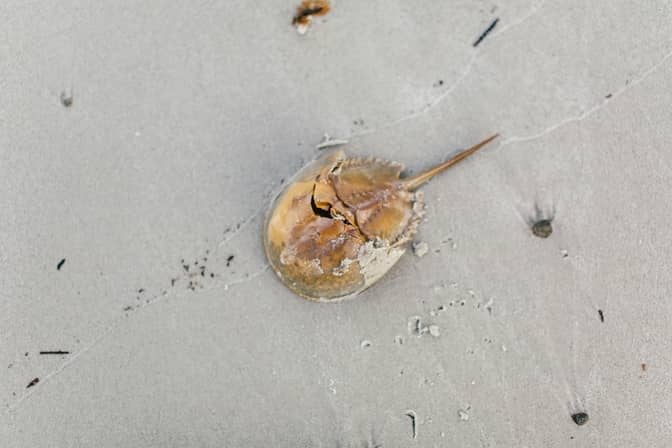 Horseshoe crabs are arthropods of marine and brackish water that have been around here on earth for more than 300 million years. Although they look like the superior-looking twins of regular crabs, horseshoe crabs are more or less like the prehistoric crabs, but they share a deep resemblance with the scorpions and spiders. Horseshoe Crabs have a horseshoe-shaped carapace that covers their arched forebody, followed by a smooth abdomen with spines on its sides with a thin and long tail that helps them in steering through the water.
Horseshoe crabs are arthropods of marine and brackish water that have been around here on earth for more than 300 million years. Although they look like the superior-looking twins of regular crabs, horseshoe crabs are more or less like the prehistoric crabs, but they share a deep resemblance with the scorpions and spiders. Horseshoe Crabs have a horseshoe-shaped carapace that covers their arched forebody, followed by a smooth abdomen with spines on its sides with a thin and long tail that helps them in steering through the water.
A Horseshoe crab’s diet consists of worms, clams, small fish, mollusks, and they also feed on algae. The natural habitat of horseshoe crabs is usually shallow coastal waters with soft sandy bottoms or a muddy plain beneath. Their population is mainly distributed in the Atlantic coast of North America, the Indian Ocean, and along the coast of Asia.
Horseshoe Crabs have hemocyanin in their blood to carry oxygen to spike up energy and meet the bodily requirement for oxygen. Hemocyanin contains copper in it, which causes the blue coloration of their blood. Apart from hemocyanin, their blood contains amebocytes, which serve as white blood cells in their body, defending the organism against pathogens.
3.) Scorpions
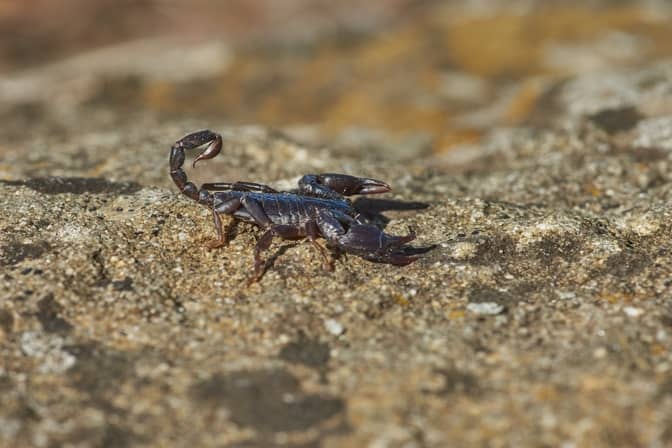
These eight-legged nocturnal arthropods are infamous for their long segmented tail that contains toxins or venom potential enough to prove fatal for a human. To add to that are the narrow pair of pincers to grasp the predators or utilize in self-defense.
A Scorpion’s size varies from 9mm to 34cm in length, with them feeding on pill bugs, snails, small invertebrates such as lizards, snakes, and rodents. They can be cannibalistic, sometimes seen feeding on other scorpions that are lesser their age and size.
With a dual functioning venom gland that secretes two types of venom for defense and hunting, respectively, scorpions are mainly unsocial and solitary animals known for their aggressive nature. However, they are highly adaptable, finding their occurrence in intertidal zones to snow-covered mountains, usually hiding in their burrows during the day.
Scorpions have pale-blue to off-blue coloration in the blood that is a result of the respiratory pigment hemocyanin binding to the oxygen. However, when the blood is deoxygenated, it appears colorless, and when it is oxygenated, it appears blue in color due to the copper (in hemocyanin) doing wonders with oxygen.
Which Animals Have Green Blood?
Lime-green colored blood? Sounds like a part of the zombie-cult! Although the complex mechanism behind the green coloration of blood in skinks and leeches steers in a completely different direction, and it doesn’t include zombies!
Skinks have RBCs that contain hemoglobin. Then why does its blood appear green? Unlike humans, skinks have a different process of recycling hemoglobin than humans, so when hemoglobin is recycled to form biliverdin, it isn’t converted to form bilirubin (unlike humans that filter out the yellowish biliverdin as soon as they can to prevent it from causing toxicity and even jaundice in the body).
The half-stuck hemoglobin formation in skinks allows biliverdin to build up in their body, which swaps the dominating red color of the hemoglobin, therefore making the blood appear green.
On the other hand, in leeches, the presence of respiratory pigment chlorocruorin and its binding with oxygen gives leeches’ blood the green color. If the pigment is present in higher amounts, it can make the leech’s blood appear red in color, making it somewhat confusing to distinguish leeches from other worm-like creatures.
1.) Leeches
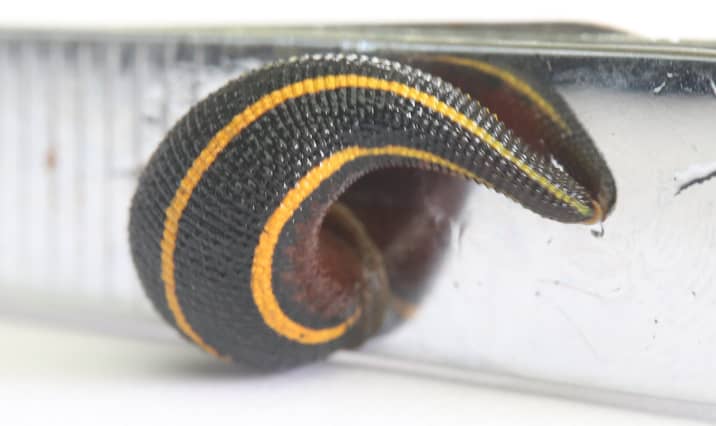
Leeches are segmented parasites with soft, muscular, and segmented bodies which they can lengthen and contract to get in that thick body and suck the blood out (no kidding!). They have suckers at both ends, so they don’t really have a tail but double the problems once they attach themselves to you.
Mostly parasites that feed on the host’s blood, there are some species that feed on small invertebrates, including snails, earthworms, and insect larvae. They have a nervous system formed of some large nerve cells, which helps them to detect touch, vibration, and movement of objects nearby, which they cleverly (just metaphorically) use to detect warm-blooded hosts.
The positive part that comes towards the end is that they have fortunately found their use in myriad medicinal applications that benefit human health in multiple ways. If you’re wondering where you are likely to encounter one- some species of leeches are found in terrestrial and marine environments, whereas the majority of them live in freshwaters.
Leeches have chlorocruorin protein present in their blood, it is an oxygen-binding protein which is found in the plasma of their blood, and it’s the behind the green coloration of their oxygenated blood, and sometimes it turns the blood into a light red color in higher concentration.
2.) Skinks
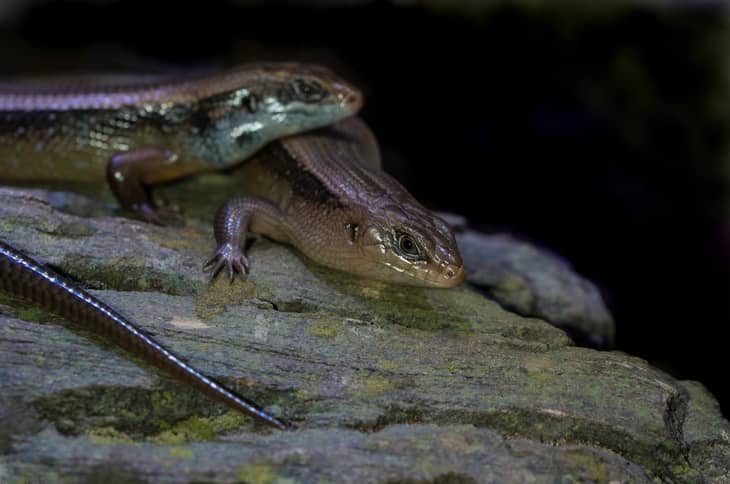
Skinks are the New Guinean lizards, with legs that are proportional to their body size. With a skull that is covered in ample bony scales, Skinks are just as ‘skinny’ as they can get with reduced limbs and less than five toes on each foot.
Most of the skinks have long and tapering tails that they can shed if they get grabbed by a predator and are quite small in size ranging from 7-15 cm, with more than half of this length covered by the tail.
Skinks have mastered the art of camouflage with their ability to easily hide in their habitat, which consists of leaves, long grass, and rocks to keep a watch on their prey. They often hide in logs to stay out of reach of large predators and save themselves a bad day. They usually feed on invertebrates, which include moths, earthworms, flies, grubs, caterpillars, spiders, slugs, and other small insects.
Skinks have green-colored blood because of the high concentration of biliverdin, a green bile pigment that is toxic and causes jaundice.
Which Animals Have Yellow Blood?
Beetles, sea squirts, and sea cucumbers have an exceptionally high amount of vanabin in their blood. It may not aid in the transportation of oxygen through the body (which is why researchers aren’t sure as to why it’s present in the blood anyway), but it contains a chemical called vanadium that is mostly responsible for imparting the squishy yellow color to the blood in its oxygenated state.
1.) Sea Cucumbers
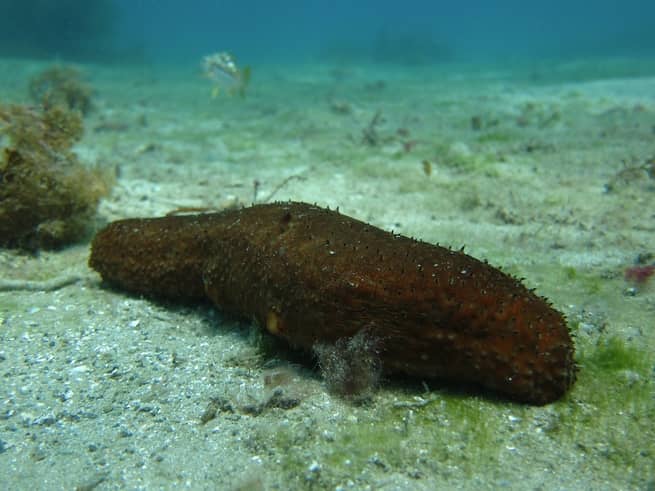
Sea Cucumbers have a soft cylindrical body betting their name that contains ‘cucumber’, also strongly supported by the dull and yellowish appearance of their body. Sea Cucumbers generally grow up to 10-30cm in length, with no arms.
This might come off weird, but they do not have a true brain, and their neural tissue surrounds the oral cavity sending nerves to the tentacles and pharynx. These nerve endings give the sea cucumbers a sense of touch and sensitivity to the presence of light, thus the fact that they have partial brains (or sense).
Sea Cucumbers have respiratory trees that branch inside the anus, so they extract oxygen from water and breathe by expelling and drawing in water through the anus. Sea Cucumbers are mainly found in the deep seafloor, where they make up the majority of the animal biomass. They form large herds and move across the ocean, hunting food, including debris, plankton, and decaying organic matter.
The yellow coloration of blood in Sea Cucumbers is due to vanabin, a vanadium-based pigment but vanabin. Here’s the catch, however- vanabin doesn’t transport or carry oxygen, so here, we do not have a case that causes coloration of blood just because some random pigment loves the oxygen in the blood.
2.) Beetles
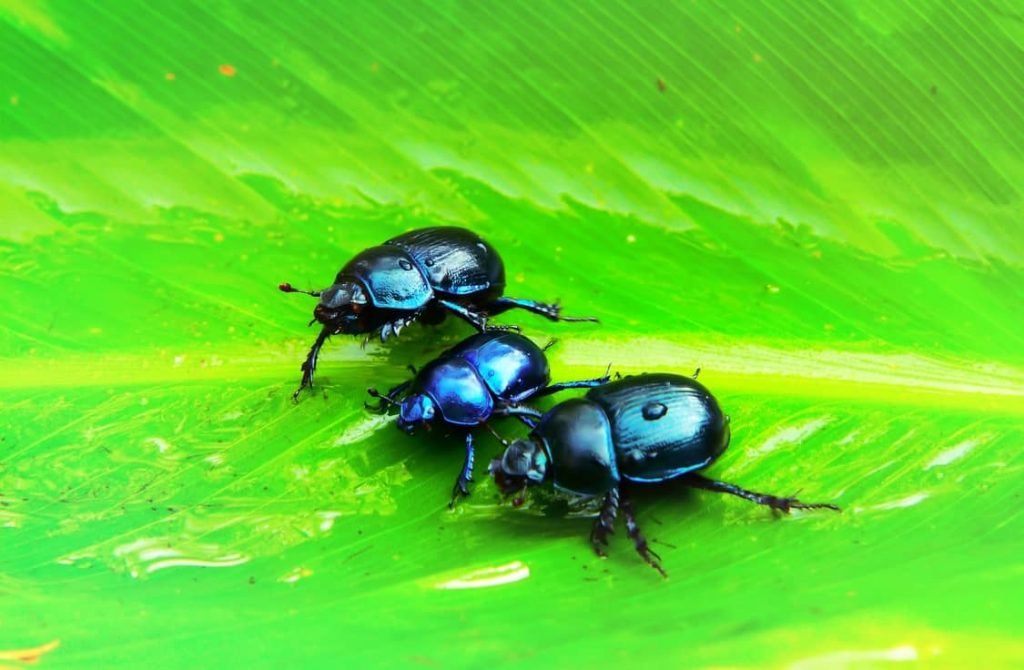
If you’ve ever watched Doraemon, the Japanese cartoon show, as a kid, you must have heard of them- the showmakers looked obsessed with these creatures, especially the rhino head ones.
Beetles are of immense value to humans as decomposers and predators (of other small insects), thus reducing unwanted fauna in an ecosystem. The fact that they symbolize love, persistence, and even luck, tells a lot about the worth of beetles in the spiritual world, which is why they are so popular amongst bugs, in general.
The adults have two sets of wings, and their lifespan is short, usually limited to a year or so. Similar to ants, beetles communicate through pheromones and vibrations with over 300,000 species in the world. They showcase high adaptability to any environment, and a major part of the population is found in the U.S.
Beetles have pale yellow blood that comes from the high amount of vanabin in their body. The vanabin isn’t directly responsible for the yellow coloration; however, the chemical vanadium in vanabin imparts a yellow color to the insect’s blood when oxygenated.
Animals with no blood color:
While we talked about animals with blood color that isn’t synonymous with red, there are also animals with no blood at all! These animals with no blood are always simple organisms with no such complex mechanisms to deal with. They are always found in the water, preferably in seas and deep in the oceans.
Why? It turns out that to survive on the land, the creatures would have to hunt and prey instead of living on what the water brings in. They need complex mechanisms and perform actions that are not possible without blood, so there are no land animals without blood as of yet, and all these bloodless animals belong to marine life.
1.) Jellyfish
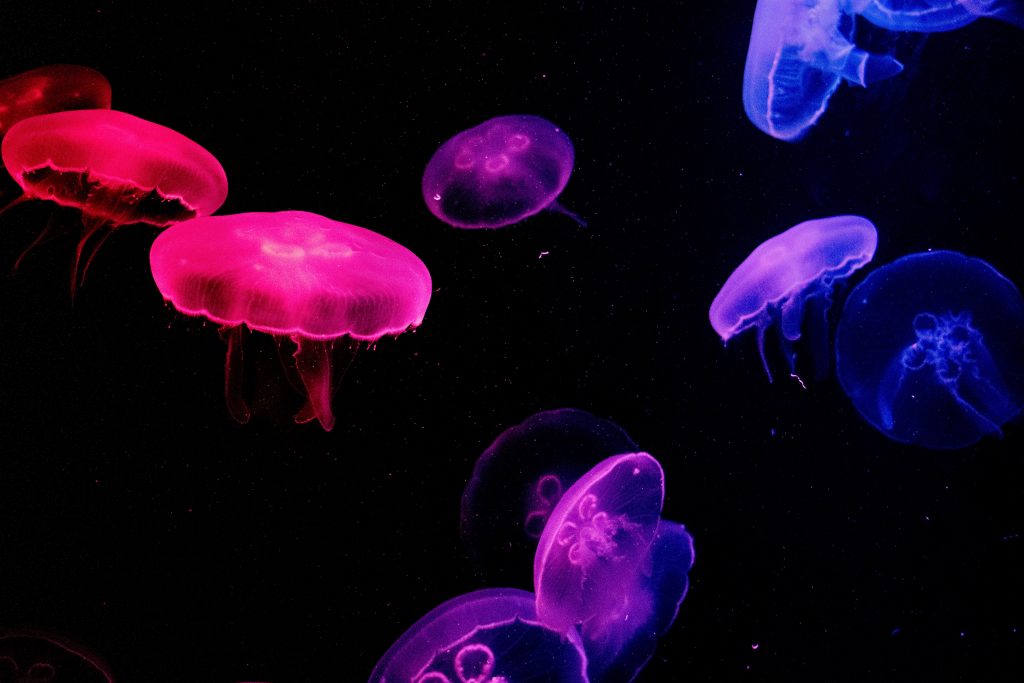
Jellyfish are amazing gelatinous sea creatures with no brain, no heart, and blood color. Not sure how they function WITHOUT all that!
Jellies have a saucer-shaped body and are often found drifting along the shoreline, with their body size ranging from about 2-40cm in diameter. The stinging cells located in their tentacles help the jellies to stun or paralyze their prey. The sting may not always be lethal, but it’s sure to spoil your nice beach day when you planned to soak into the water and bask in the sun all day.
The bodies of jellies are made up of 95% water, which forms the bulk in their body, making them completely transparent and magical to look at, at the same time. Jellies mainly feed on small plants, fish eggs, copepods, and the young ones of other marine animals while also showing cannibalism from feeding upon other older or baby jellies.
Read: What Do Jellyfish Eat? (And How Do They Eat?)
2.) Corals
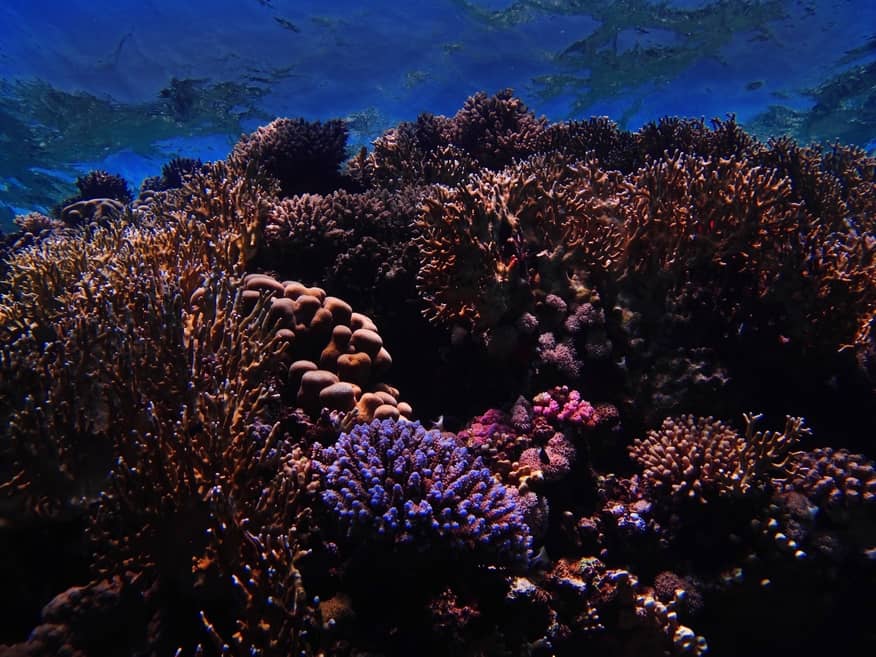
Corals do not have blood. It is obvious! Corals do not possess a circulatory system, just like all the other animals that fall under the nematode category, and without a circulatory system, the existence of blood is impossible (duh!). Their body cavity has no lining, and the inner has no fluids- the intake of nutrients and the transport of it throughout the body is done through the water directly.
3.) Sea Anemones
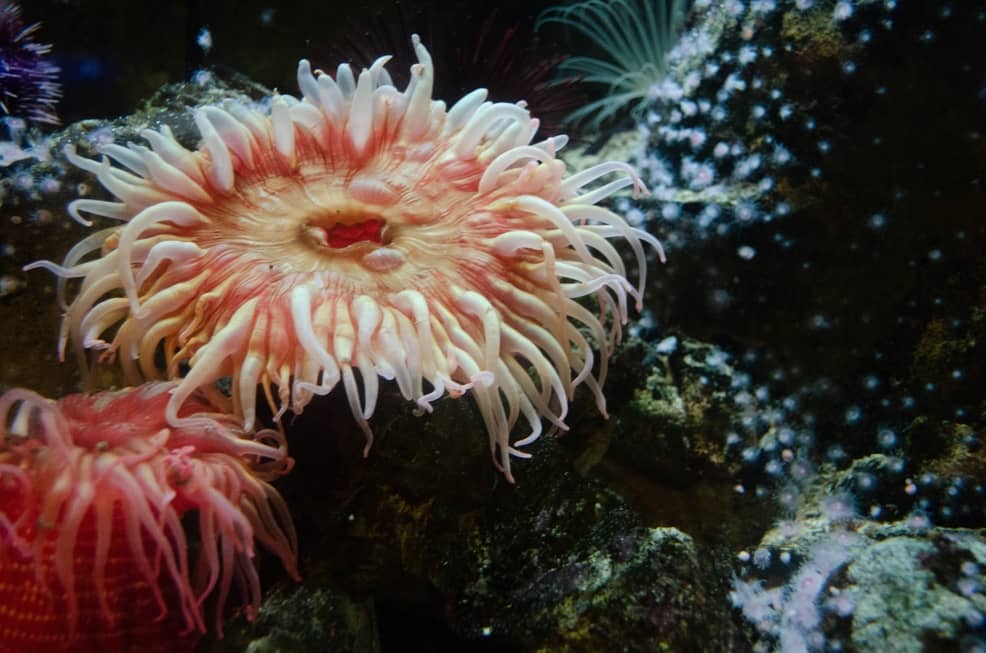
Sea Anemones are harmless-looking creatures that are actual marine predators with bright, colorful appearance, usually associated with clownfish. Sea Anemones are attached to a hard surface by the base and have a column-shaped body structure topped by an oral disk. Their columns are cylindrical in shape with a plain and smooth texture, with the oral disks serving as a slit-shaped central mouth.
Sea Anemones usually size up from 1-6cm in diameter and 1.4-12 cm in length, which may vary in dimensions because they are inflatable. They feed on zooplankton, fish, shrimp, marine larvae, worms, and small crustaceans and are found worldwide in shallow coastal waters and deep oceans.
4.) Sponges
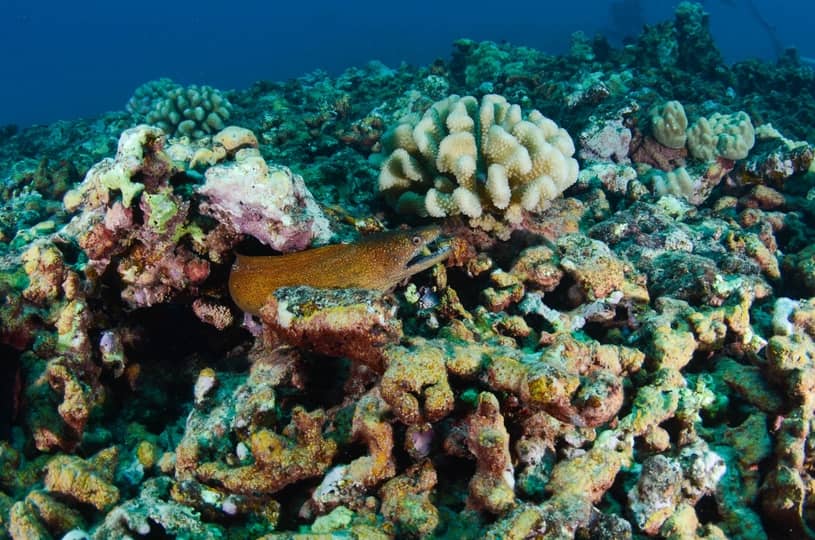
A sponge has many pores on its body through which the water flows in and out and brings food and oxygen to them. They are one of the simplest organisms for which blood is a very complex science, so they don’t possess it in the first place.
Sponges have different forms, including tubes, fans, cups, cones, barrels, and crusts. They are filter feeders, eating small floating organic particles and plankton that they collect from the water flowing in and out.
Sources
- Dylan Roach, Jessica Orwig, Animal blood comes in 5 crazy colors, Business Insider.
-
Carrie Arnold, In Animal Kingdom, Blood Comes in a Rainbow of Colors, National Geographic.






